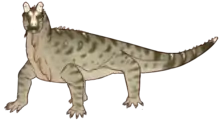Bharitalasuchus
Bharitalasuchus is an extinct genus of erythrosuchid archosauriform known from the Middle Triassic Yerrapalli Formation of India. It contains a single species, Bharitalasuchus tapani, known from a holotype and paratype consisting of tooth-bearing cranial fragments (maxillae and possible premaxillae), at least 17 presacral vertebrae, ribs, probable intercentra, fragmentary pectoral and pelvic girdles, a femur, and tibiofibular elements,[1] with the whole animal being ~2.3 meters (7.5 feet) in length.[1] The discovery and description of this taxon was important for the understanding of not only the age of the Yerrapalli Formation, but also the global distribution of the erythrosuchids at the time of their demise.[1]
| Bharitalasuchus | |
|---|---|
| Scientific classification | |
| Domain: | Eukaryota |
| Kingdom: | Animalia |
| Phylum: | Chordata |
| Class: | Reptilia |
| Family: | †Erythrosuchidae |
| Genus: | †Bharitalasuchus Martin Ezcurra et al. 2021 |
| Species: | †B. tapani |
| Binomial name | |
| †Bharitalasuchus tapani Martin Ezcurra et al. 2021 | |
Discovery and classification
The first remains of Bharitalasuchus were recovered from the Yerrapalli Formation in the 1960s[2] and housed in the Indian Statistical Institute of Calcutta, but were never formally described until 2021, being named Bharitalasuchus tapani after the Telugu words "Bhari," meaning large, and "Tala," meaning head; along with the species name tapani as a tribute to Indian paleontologist Tapan Roy Chowdhury.[2] It consists of a holotype and referred paratype[1] with distinguishing autapomorphies being the unique combination of character states of features of its vertebrae and other postcranial elements combined.[1] The phylogenetic analysis conducted by Ezcura et al. after its discovery found the species to be closest to Shansisuchus shansisuchus and Chalishevia cothurnata from China and Russia respectively.[1] Its discovery has important implications on the geographical and temporal range of the erythrosuchids by the time of their extinction.[1][2]
References
- Ezcurra, Martin; Bandyopadhyay, Saswati; Gower, David (2021). "A NEW ERYTHROSUCHID ARCHOSAURIFORM FROM THE MIDDLE TRIASSIC YERRAPALLI FORMATION OF SOUTH-CENTRAL INDIA". Ameghiniana. 58 (2). doi:10.5710/AMGH.18.01.2021.3416. S2CID 234217303. Retrieved 30 April 2021.
- "Paleontologists led by a CONICET researcher unveil a new 240-million-year-old species of reptile from India, similar to a creature from Star Wars". MACNConicet.gob.ar. MACN Conicet.




